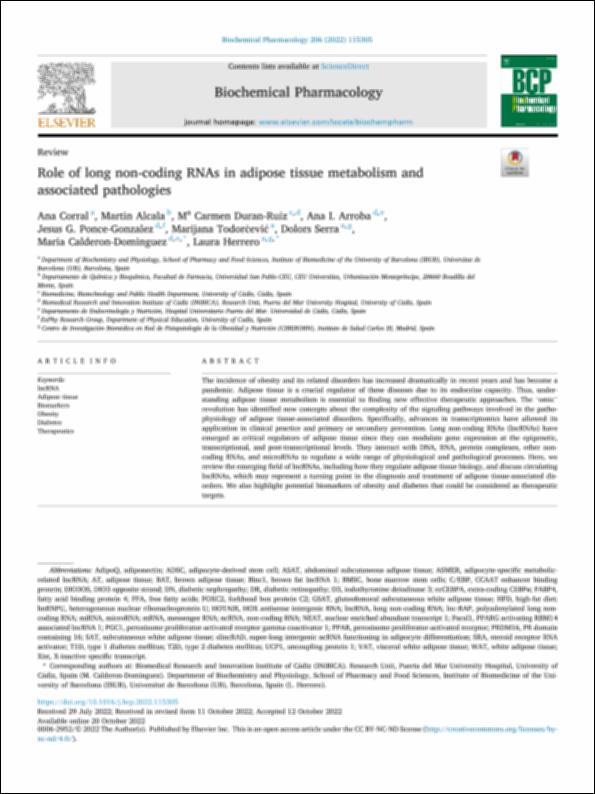Please use this identifier to cite or link to this item:
http://hdl.handle.net/10637/14548Role of long non-coding RNAs in adipose tissue metabolism and associated pathologies
| Title: | Role of long non-coding RNAs in adipose tissue metabolism and associated pathologies |
| Authors : | Corral, Ana Alcalá Díaz-Mor, Martín Durán Ruiz, María Carmen Arroba, Ana I. Ponce González, Jesús G. Todorcevic, Marijana Serra, Dolors Calderón Domínguez, María Herrero Rodríguez, Laura |
| Keywords: | lncRNA; Adipose tissue; Biomarkers; Obesity; Diabetes; Therapeutics |
| Publisher: | Elsevier |
| Citation: | Corral A, Alcala M, Carmen Duran-Ruiz M, Arroba AI, Ponce-Gonzalez JG, Todorčević M, Serra D, Calderon-Dominguez M, Herrero L. Role of long non-coding RNAs in adipose tissue metabolism and associated pathologies. Biochem Pharmacol. 2022 Dec;206:115305. doi: 10.1016/j.bcp.2022.115305. |
| Abstract: | The incidence of obesity and its related disorders has increased dramatically in recent years and has become a pandemic. Adipose tissue is a crucial regulator of these diseases due to its endocrine capacity. Thus, understanding adipose tissue metabolism is essential to finding new effective therapeutic approaches. The “omic” revolution has identified new concepts about the complexity of the signaling pathways involved in the pathophysiology of adipose tissue-associated disorders. Specifically, advances in transcriptomics have allowed its application in clinical practice and primary or secondary prevention. Long non-coding RNAs (lncRNAs) have emerged as critical regulators of adipose tissue since they can modulate gene expression at the epigenetic, transcriptional, and post-transcriptional levels. They interact with DNA, RNA, protein complexes, other noncoding RNAs, and microRNAs to regulate a wide range of physiological and pathological processes. Here, we review the emerging field of lncRNAs, including how they regulate adipose tissue biology, and discuss circulating lncRNAs, which may represent a turning point in the diagnosis and treatment of adipose tissue-associated disorders. We also highlight potential biomarkers of obesity and diabetes that could be considered as therapeutic targets. |
| URI: | http://hdl.handle.net/10637/14548 |
| Rights : | http://creativecommons.org/licenses/by-nc-nd/4.0/deed.es openAccess |
| Issue Date: | 20-Oct-2022 |
| Center : | Universidad San Pablo-CEU |
| Appears in Collections: | Facultad de Farmacia |
Items in DSpace are protected by copyright, with all rights reserved, unless otherwise indicated.


